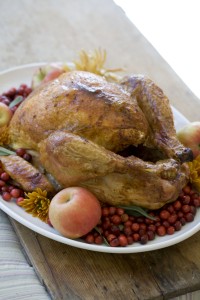
BYU students and faculty are getting excited for their Thanksgiving break, or more specifically the feast that awaits them. While many people are not aware of how many calories they consume at the Thanksgiving dinner table, there are ways to stay healthy and manage body weight during the holidays.
“I always look forward to Thanksgiving dinner because it is the one time of the year when you get to splurge and not care at all about the amount of calories you are eating,” said Kathryn Arbon, a nursing major. “They don’t count that day.”
However, calories do count, no matter what day of the year it is, and many people end up seeing those calories on their bodies as unwanted pounds when the holidays wind down.
According to Time Magazine, the average Thanksgiving feast consists of these items: turkey, with skin, stuffing, dinner roll and butter, sweet-potato casserole, mashed potatoes and gravy, green-bean casserole, cranberry sauce, brussels sprouts, pumpkin pie, pecan pie and whipped cream. If a person ate proper plate proportions during their Thanksgiving meal, the meal’s calories would amount to about 2,486 calories.
This list does not take into account second, third, and fourth helpings of food that most people indulge in at most Thanksgiving tables. According to the Calorie Control Council, “The average American may consume more than 4,500 calories and a whopping 229 grams of fat during Thanksgiving.”
It is no wonder many people become tired after eating plates of foods because the body needs time to rest and digest all those calories.
“On Thanksgiving there are a lot of factors that make me tired,” said Christina Riley, a psychology major. “You wait all day to eat a big meal, you eat more than you are supposed to and you add that to tryptophan, and that equals a nap.”
Tryptophan is an amino acid found in turkey. This acid helps the body produce the B-vitamin niacin, which in turn helps the body produce serotonin, the chemical that acts as a calming agent in the brain and helps you sleep. Tryptophan works best on an empty stomach, and since many people don’t eat before their Thanksgiving feast, turkey has that much more of an effect on them.
After a long day of eating and getting sleepy from turkey, it is no shock many Americans gain weight during the holidays, starting with Thanksgiving. According to the Calorie Control Counsel, “It’s commonly believed that Americans gain, on average, five to 10 pounds between Thanksgiving and New Year’s. However, it turns out that the average gain is closer to one pound — but think about gaining a pound every year, and it adds up over time.”
Keeping the weight off is a balance of exercise and diet. Holidays like Thanksgiving can definitely demolish any healthy diet or exercise habits. Yet, there are many solutions to help stay active and eat right, even on Turkey Day.
For exercise, many families play in a turkey bowl on Thanksgiving day. Being active with family and friends will help revive and boost energy. If the weather is bad, bundle up and play in the rain or snow. Take a walk with loved ones after dinner, or play JustDance and laugh as people shake it. The options are endless, staying active can burn excess calories and make an even more enjoyable holiday.
On Thanksgiving, most people lose self control over how much they eat. Though part of the fun is in seeing how much they can stuff themselves with, remember that by New Year’s they may be trying to stuff their bodies into clothes that don’t fit anymore.
Eat up, but just be make sure to either buy bigger clothes or to run a few more laps.




